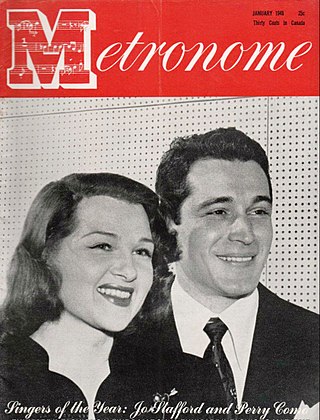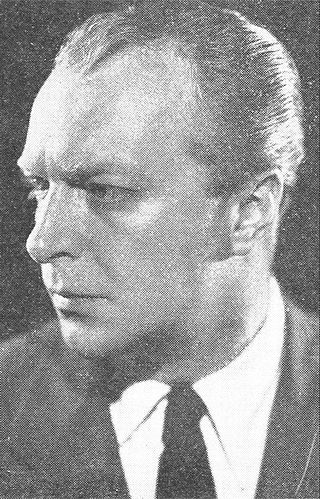Dan Seymour (June 28, 1914 – July 27, 1982) [1] was an announcer in the era of old-time radio and in the early years of television [2] and later became an advertising executive. [1]
Dan Seymour (June 28, 1914 – July 27, 1982) [1] was an announcer in the era of old-time radio and in the early years of television [2] and later became an advertising executive. [1]
Seymour was born in Manhattan. He attended schools in Paterson, New Jersey, and graduated from Montclair Academy. [3] When he was 18, he traveled to study and teach stage techniques as a guest of the Austrian Ministry of Education. [4] He was a dramatics major at Amherst College. [5]
Seymour was once recognized as "Radio's best announcer." [4] An obituary observed: "Seymour was best known as the deep-voiced announcer who startled Americans with a convincing but fictional account of Martians landing on Earth in the War of the Worlds broadcast in 1938." [6]
His first job in radio announcing came in 1935 at WNAC in Boston, Massachusetts, after his college graduation. [3] While at the station, he was also an announcer for the Yankee Network. In 1936, he resigned and joined CBS in New York City. [7] His first major assignment there was announcing for Major Bowes Amateur Hour . [8]
A significant assignment early in his career was becoming the announcer on We the People, a job that led to a position with the program's advertising agency, Young and Rubicam. [4]
Other programs on which Seymour worked as announcer were The Henry Morgan Show , [9] : 304 The Aldrich Family , [9] Songs by Jack Smith, [10] Aunt Jenny's Real Life Stories , [11] Sing It Again , [12] Bobby Benson , [13] and Original Gillette Community Sing. [13] : 45
Seymour was one of the producers of You and the News. [14]
Seymour was master of ceremonies on Where Was I? [15] and Sing It Again. [16] : 972 He was the announcer for Tex and Jinx, [16] : 1063 Dunninger and Winchell, (also known as The Bigelow Show for part of its run), [16] and The Swift Home Service Club. [16] : 1045
In 1945, Seymour, director Tony Leader, and writer Judson Phillips combined efforts to create P.L.S. Productions, a radio producing team, with offices in New York City. The team's first program was You Make the News, which began November 15, 1945, on the Mutual Broadcasting System. [17]
Three months after Seymour became producer of We the People in February 1950, the program's television Nielsen rating had almost doubled. [18]
In 1950, Seymour left the on-air side of broadcasting to work in programming. He explained his transition by saying: "I never really enjoyed being a performer. The process of simply reading lines became a bore. I became fascinated with the whole business of mass communications and mass persuasion. This was where the challenge lay." [3]
He first was employed by the Young & Rubicam advertising agency. [19] An invitation to "administer a lift to the General Electric program" for Y & R led to "a permanent role with the agency as a television and radio executive." [4] In 1953, he was appointed a vice president in charge of programming in the agency's radio-television department. [20] He resigned from Y & R October 1, 1955, to become a vice president of the J. Walter Thompson advertising agency. [21] Later, he became president and chief executive officer at the Thompson agency. [22]
In 1946, Seymour and Kathryn Murray shared narration on an eight-sided 78rpm album, Arthur Murray Teaches the Fox Trot. The instructional recordings were issued in conjunction with Arthur Murray's dance studios. [23]
Seymour was elected to one-year terms on the board of the New York City local of the American Federation of Radio Artists for 1948 [24] and 1949. [25]
Seymour served on two ad hoc committees appointed by two United States presidents. Under Lyndon Johnson, he was on a committee "to make recommendations for improvements in United States foreign trade." Under Richard Nixon, he was on a committee "to find ways to increase public awareness on personal health." [3]
Seymour was married to the former Louise Scharff. They had four children. [4]
Seymour died of a heart attack July 27, 1982, at his apartment in New York City. He was 68. [6] He was survived by his wife, a son, three daughters and 10 grandchildren. [3]
Ernest E. Chappell was an American radio announcer and actor, best remembered for his featured role in the late 1940s radio program Quiet, Please. The show ran from 1947 to 1949, and Quiet, Please was Chappell's major acting credit. His signature line was: "And so, until next week at this same time, I am quietly yours, Ernest Chappell."

William Nettles Goodwin, was an American radio announcer and actor. He was for many years the announcer and a recurring character of the Burns and Allen radio program, and subsequently The George Burns and Gracie Allen Show on television from 1950–1951. Upon his departure, he was replaced by Harry von Zell.

The Chesterfield Supper Club is an NBC Radio musical variety program (1944–1950), which was also telecast by NBC Television (1948–1950).
David Ford Bond was an American radio personality.

Phillips Carlin was a radio broadcaster, a radio executive, and later, a television executive.

Francis Michael Dunne was an American actor, radio personality and disc jockey. He was active in television and films from 1945 to 1973, and was also credited as Steve Dunn, Michael Dunne, Stephan Dunne, and Steve Dunne.

Mail Call was an American radio program that entertained American soldiers from 1942 until 1945, during World War II. Lt. Col. Thomas A.H. Lewis wrote in 1944, "The initial production of the Armed Forces Radio Service was 'Mail Call,' a morale-building half hour which brought famed performers to the microphone to sing and gag in the best American manner." The program featured popular entertainers of that day, such as Bob Hope, Bing Crosby, Judy Garland, and Dinah Shore, performing musical numbers and comedy skits to boost the morale of soldiers stationed far from their homes. Lewis added, "To a fellow who has spent months guarding an outpost in the South Seas, Iceland or Africa a cheery greeting from a favorite comedian, a song hit direct from Broadway, or the beating rhythm of a hot band, mean a tie with the home to which he hopes soon to return.

Gene Autry's Melody Ranch is a Western variety radio show in the United States. A 15-minute pilot show aired on December 31, 1939. The program ran from January 7, 1940 to August 1, 1943, and from September 23, 1945 to May 16, 1956. The show's entire run was broadcast over the CBS radio network, sponsored by Doublemint gum. The approximately two-year interruption resulted from Autry's enlistment in the United States Army to serve in World War II. Initially titled Doublemint's Melody Ranch, the show's name was changed to Gene Autry's Melody Ranch in early 1941. Episodes were 30 minutes long except for a 15-minute version that ran from September 23, 1945 to June 16, 1946. The theme song was "Back in the Saddle Again".

Club Fifteen is a radio program in the United States that featured popular music. It was broadcast weeknights 30 June 1947 – 21 December 1951. Then, it aired Monday, Wednesday, and Friday nights until 16 January 1953. The name reflected the program's length—15 minutes. The Historical Dictionary of Old-Time Radio noted that the show "is sometimes listed as Bob Crosby's Club Fifteen because Bob Crosby was the original star, although Dick Haymes took over in 1949-50." The program was sponsored by Campbell Soups.

Matt Crowley was an American film, television and radio actor.

Dick Joy was an American radio and television announcer. A journalism major at the University of Southern California, he went on to become well known on network radio and television.

Nelson Case was an American radio and television announcer.

The Frank Sinatra Show was a title applied—in some cases specifically and in other cases generically—to several radio musical programs in the United States, some of which had other distinct titles as indicated below. Singer Frank Sinatra starred in the programs, some of which were broadcast on CBS, while others were on NBC.

Staats Cotsworth was an American actor in old-time radio. He is perhaps best known for playing the title role in Casey, Crime Photographer.
Curtain Time is a radio anthology program in the United States. It was broadcast on ABC, CBS Mutual, and NBC during the old-time radio era, beginning in 1938 and ending in 1950.

Helen Claire was an actress on Broadway and in old-time radio.

House Baker Jameson was an American actor in the era of old-time radio and early television.

Ted Steele was an American bandleader and host of several radio and television programs. He also held administrative positions at radio stations and had his own media-related businesses.

Bride and Groom is an old-time radio human-interest program in the United States. It was broadcast on ABC from November 26, 1945, to September 15, 1950. Each episode featured an engaged couple who would be married during the broadcast, then showered with gifts.

Constance Bennett Calls on You is an American old-time radio talk show. It was broadcast on ABC May 21, 1945 – March 15, 1946. Beginning November 20, 1945, it was also carried on CJBC in Toronto, Canada. The program was also known as The Constance Bennett Show.